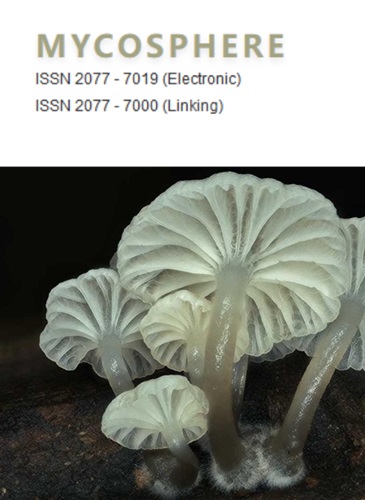标题胞孢子科中具有性别形态的胞孢子属的补充
IF 15.1
1区 生物学
Q1 MYCOLOGY
引用次数: 14
摘要
胞孢子菌是一种重要的病原菌,分布在世界各地,寄主范围广,通常与树木枯死病和溃疡病有关。缺乏前型培养或无法将GenBank中的多基因DNA序列数据与系统发育分析联系起来,使得很难将胞孢子虫分类群划分到物种水平。本研究从中国、意大利和泰国的枯木中采集了10份胞孢子虫标本。根据其形态和系统发育特征,对4个新种(C. diopuiensis、C. galegicola、C. pingbianensis和C. pubescentis)和4个已知种(C. cedri、C. cotini、C. predappioensis和C. prunicola)进行了描述、说明,并与相关分类群进行了比较。详细描述了全形态(C. galegicola、C. prunicola、C. predpioensis和C. pubescentis)、性形态(C. cedri、C. cotini、C. diopuiensis和C. pingbianensis)和中国新记录的C. preddappioensis。ITS, LSU, ACT和RPB2 DNA序列数据集的系统发育分析支持它们在胞孢子属中的位置,并证明了新种和已知种的鉴定。本文章由计算机程序翻译,如有差异,请以英文原文为准。
Additions to the genus Cytospora with sexual morph in Cytosporaceae
Cytospora species are important pathogens, which have a worldwide distribution, broad host range and are commonly associated with tree dieback and canker disease. Lack of ex-type cultures or inability to link multi-gene DNA sequence data in GenBank to phylogenetic analyses makes it difficult to classify Cytospora taxa to species level. In this study, ten specimens of Cytospora were collected from dead wood in China, Italy and Thailand. Based on their morphology and phylogenetic characterization, four new species (C. diopuiensis, C. galegicola, C. pingbianensis and C. pubescentis) and four known species (C. cedri, C. cotini, C. predappioensis and C. prunicola) are herein described, illustrated and compared with related taxa. Detailed morphological descriptions of the holomorph (C. galegicola, C. prunicola, C. predappioensis and C. pubescentis), the sexual morph (C. cedri, C. cotini, C. diopuiensis and C. pingbianensis) and a new record of C. predappioensis in China are provided. Phylogenetic analyses of a combined ITS, LSU, ACT and RPB2 DNA sequence dataset support their placement in the genus Cytospora and justify the new species and identification of known species.
求助全文
通过发布文献求助,成功后即可免费获取论文全文。
去求助
来源期刊

Mycosphere
MYCOLOGY-
CiteScore
30.00
自引率
8.20%
发文量
9
审稿时长
4 weeks
期刊介绍:
Mycosphere stands as an international, peer-reviewed journal committed to the rapid dissemination of high-quality papers on fungal biology. Embracing an open-access approach, Mycosphere serves as a dedicated platform for the mycology community, ensuring swift publication of their valuable contributions. All submitted manuscripts undergo a thorough peer-review process before acceptance, with authors retaining copyright.
Key highlights of Mycosphere's publication include:
- Peer-reviewed manuscripts and monographs
- Open access, fostering accessibility and dissemination of knowledge
- Swift turnaround, facilitating timely sharing of research findings
- For information regarding open access charges, refer to the instructions for authors
- Special volumes, offering a platform for thematic collections and focused contributions.
Mycosphere is dedicated to promoting the accessibility and advancement of fungal biology through its inclusive and efficient publishing process.
 求助内容:
求助内容: 应助结果提醒方式:
应助结果提醒方式:


